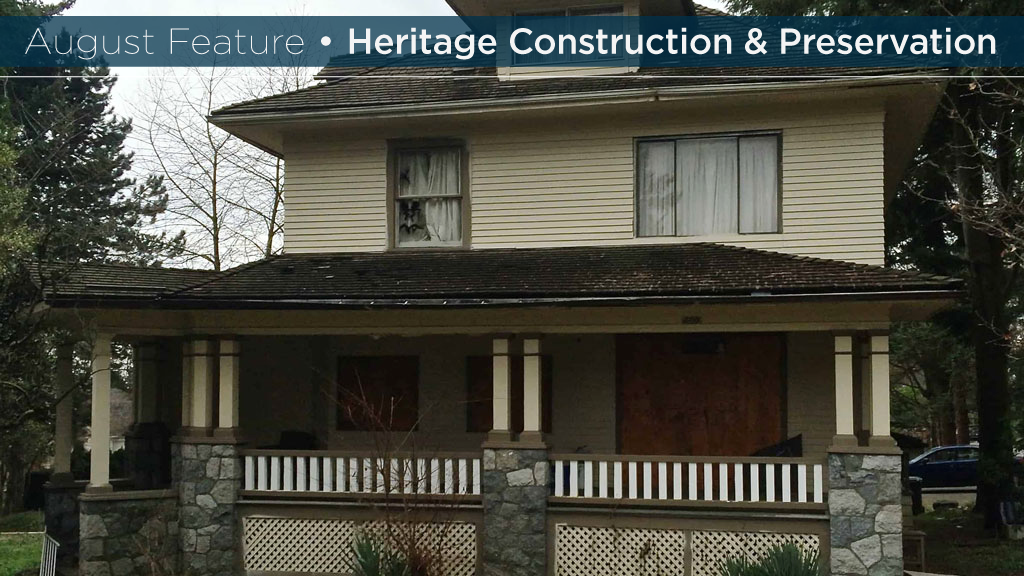Trasolini Construction Corp. is rehabilitating and renovating an old Vancouver farmhouse to bring it back to its original form.
The Morrisette farmhouse, a designated heritage building on the corner of Blenheim and Mayfair in the residential neighbourhood of Kerrisdale, was built in 1909.
At that time, much of what is now the city of Vancouver was undeveloped land. South of 25th Avenue there were only a few scattered villages here and there.
“The farmhouse had been vacant for at least 10 years,” said company owner Paolo Trasolini. “When the project is completed, there will be two suites in the original building and a third added on at the back.”
The Morissette farmhouse stands out in Vancouver. The West Coast city is young, even by Canadian standards, and it has relatively few heritage buildings.
“People here like heritage buildings.” said Michael Geller, a Vancouver developer and retired architect. “At the awards ceremonies I attend, it’s the heritage projects that get the oohs and ahhs.”
Part of the rehabilitation job on the farmhouse project involved identifying and removing any hazardous materials.
Christopher Tiner, director of business development of MB Environmental Ltd., tested the Morissette farmhouse for hazmat and removed them.
“We found asbestos and lead coatings inside the farmhouse and outside,” said Tiner. “In addition, we found mold in the attic, which isn’t surprising because of Vancouver’s humid climate.”
Dealing with the farmhouse hazmat took “three or four weeks,” although some projects can take several months.
“The farmhouse was quite a challenge for us,” said Tiner. “Numerous additions and renovations had been made to the building over the years, some of them possibly without a building permit.”
Vancouver heritage consultant Donald Luxton said asbestos and lead are the main hazardous materials that are found in old buildings.
“They were common for many years in many different products,” said Luxton. “There’s lead in paint. In heritage buildings, asbestos is found in exterior sidings, shingles, paint, plaster, insulation and vinyl floor tiles. There is usually a fair amount in older buildings.”
Luxton said lead can be encapsulated by, for example, painting over lead paint, but there’s no safe use for asbestos and it must be removed and taken to a disposal site.
Before a heritage rehabilitation project can begin, there must be rigorous testing for hazardous materials.
“We must understand exactly where the hazmat is before we start taking a building apart,” said Luxton. “Testing comes first because you can’t predict where the asbestos, lead or mold is by standing on the curb and looking, and you don’t know what the scale of the problem is until you test.”
Because the discovery of hazmat in unexpected amounts and locations can have a major impact on budgets and scheduling, specialists are brought in to do the testing and removal.
“They chart where the materials that contain hazmat are and take samples,” said Luxton. “Then the hazmat removal people come in and take out the hazmat and remove it to a disposal site.”
Luxton said dealing with hazardous materials are “just part of working with existing buildings” for heritage consultants like him.
“Sometimes we have to take out features like plaster work that has asbestos in it and replicate,” he said. “It’s factored into our conservation planning, as well as the architectural approach.”
Luxton said he is “always highly amused” when people try to use the existence of hazmat as a reason to tear a building down.
“They seem unaware of the reality that it costs just as much to remediate the hazmat whether you tear the building down or not,” Luxton said.
“The fact of the matter is that you have to deal with hazmat these days, you have no other choice.
“You’re getting involved with hazardous materials whether you’re demolishing a heritage building or rehabilitating it. And if there’s a fire and the building burns down, it will cost even more and take more time, because the site needs to be remediated.”
Unbuilders is a Vancouver company that, instead of demolishing buildings, “unbuilds” them by hand, salvaging all the useable materials that it can and donating them to charity to be reused.
“We have to follow the same hazardous material regulations as anyone who is doing a renovation of a heritage building,” said founder and owner Adam Corneil. “No exceptions for demolitions or deconstructions.”






Recent Comments
comments for this post are closed